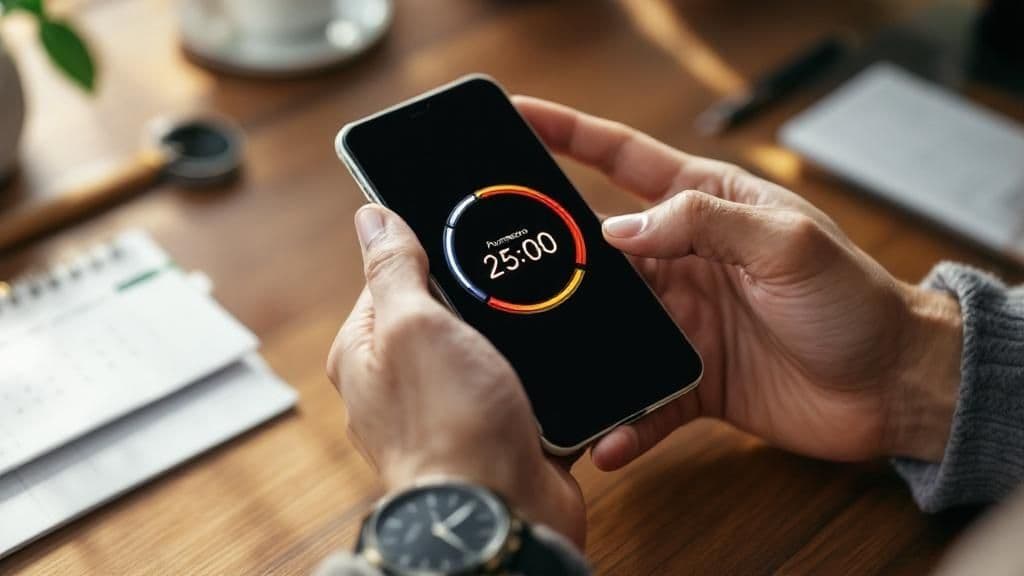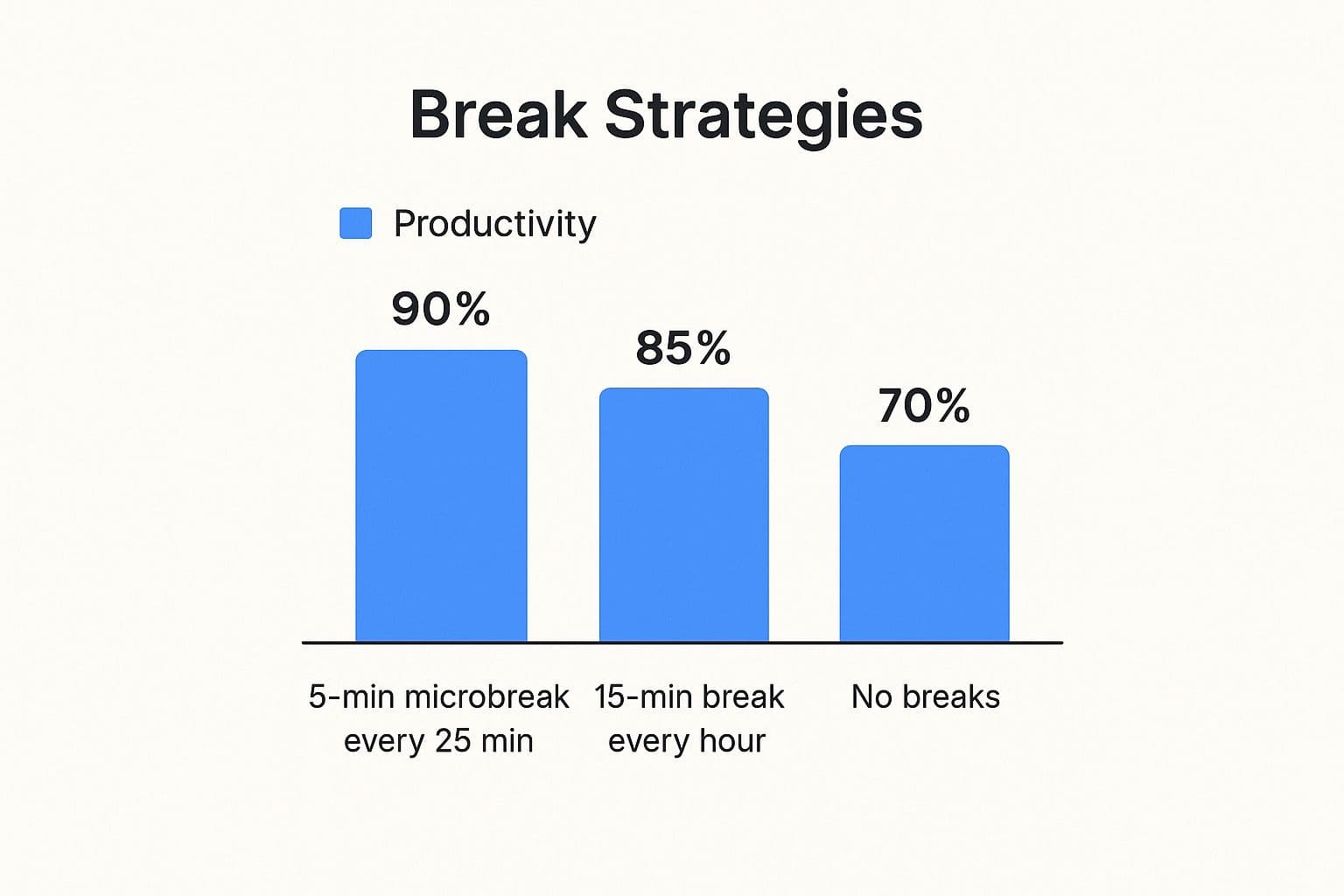How to Stay Focused at Work and Boost Productivity
Tired of endless distractions? Learn how to stay focused at work with actionable strategies to conquer interruptions and reclaim your productivity today.

Let's be real—learning how to stay focused at work isn't about some secret willpower hack. It’s about being smart and building a daily routine and workspace that shuts down distractions before they even have a chance to grab you. The trick is to take control of your attention instead of letting your day control you. This means being intentional about your space, your schedule, and how you use technology.
Why Staying Focused Feels Almost Impossible Today

If you feel like your focus shatters at the slightest provocation, you're not alone. The modern workday is a gauntlet of digital pings, endless meetings, and the mental gymnastics of task-switching. We've created a work culture that often celebrates the look of being busy over the actual, tangible results of being productive.
This constant context-switching is a productivity killer. Think about all the time you spend just getting ready to work—hunting for that one document, bouncing between ten different apps, or sitting in meetings that could have been an email. It all adds up. In fact, research shows that the average employee spends a staggering 60% of their day on this kind of "work about work."
The real problem is we often see a lack of focus as a personal failure. We beat ourselves up for getting distracted, but the issue is usually the system itself—the way our work is structured just isn't built for deep concentration.
This guide isn't here to tell you to "just try harder." It's about giving you a playbook to fight back against the culture of constant interruption and build a workday that actually works for your brain.
The Real Reasons Your Focus Is Fading
Before we get into the nitty-gritty techniques, we have to be honest about what we're up against. Today's work environment is practically designed to break your concentration.
Here are a few of the biggest culprits I see time and time again:
- The "Always On" Expectation: We're conditioned to give instant replies on Slack and email, which trains our brains to stay in a state of high alert, ready to be pulled away at any moment.
- Sky-High Stress: Juggling an overwhelming to-do list or dealing with unclear priorities creates a mental fog that makes it nearly impossible to concentrate. Learning good workplace stress management strategies is no longer a soft skill; it's a core competency for getting things done.
- The "Why Am I Doing This?" Feeling: When your daily tasks feel random and disconnected from a bigger goal, your motivation tanks. And when motivation goes, focus is right behind it.
The good news? You can absolutely reclaim your attention. This isn't about working more hours. It's about understanding these challenges and building a fortress around your focus. Let's get into how to do it.
To help you get started right away, here's a quick summary of the core strategies we'll cover. Think of it as your cheat sheet for taking back control of your day.
Your Quick-Start Guide to Reclaiming Focus
| Strategy | Primary Goal | Key Action |
|---|---|---|
| Mindful Work Planning | Stop reacting, start directing | Time-block your day for deep work and shallow tasks. |
| Workspace Optimization | Minimize external distractions | Clear your desk and digital desktop of non-essential items. |
| Taming Technology | Use tools without them using you | Turn off non-essential notifications on your phone and computer. |
| Strategic Breaks | Prevent burnout and refresh your mind | Use a technique like the Pomodoro Method (25 min work, 5 min break). |
| Energy Management | Align tasks with your natural rhythm | Tackle your most demanding work during your peak energy hours. |
This table gives you the highlights, but the real magic happens when you understand the "why" behind each action and customize it for your own workflow. Now, let's dive into the first, and arguably most important, step.
Design Your Workspace to Defeat Distractions

Look around you. Your workspace, both the physical one on your desk and the digital one on your screen, is constantly sending little messages to your brain. A messy desk piled high with paperwork or a desktop screen plastered with icons? That’s basically screaming “chaos,” making it a real battle to get into a state of deep focus.
The idea here is to get intentional about creating your own personal 'focus fortress'—a space that signals to your brain that it's time to get down to business.
This all starts with your desk. If it's a graveyard for old coffee mugs, random sticky notes, and tech gadgets you haven't touched in months, you're setting yourself up for failure. Every single one of those items is a potential rabbit hole, just waiting to pull your attention away from what actually matters.
Think of it this way: a cluttered space equals a cluttered mind. You can't expect to have mental clarity when your eyes are darting between a dozen different things. Seriously, taking just five minutes to clear your desk can make a world of difference.
When you create a clean, organized area, you're doing more than just tidying up. You're actively programming your environment to help you stay on track. This simple habit is a huge first step in learning how to stay focused at work.
Tidy Your Physical Space
What's in your direct line of sight has a massive impact on your concentration. The rule of thumb is pretty simple: if you can't see it, it's a lot harder for it to distract you.
So, start by clearing everything off your desk that isn't absolutely critical for what you're doing right now.
- Keep Only the Essentials: Your computer, a notebook, a pen, and a glass of water. That's it. Everything else can find another home.
- Move Your Phone: This is a big one. Your phone is probably the most potent distraction you own, so don't let it live on your desk. Put it in a drawer, on a bookshelf across the room, or even in another room altogether. If you have to physically get up to check it, you'll be way less likely to grab it out of habit.
- Organize Everything Else: For the stuff you need but don't need right now, use drawers, shelves, or storage bins. The "out of sight, out of mind" method works wonders for cutting down on visual noise.
Optimize Your Digital Desktop
Your digital workspace is just as important, if not more so. A chaotic computer screen with notifications pinging every few seconds is the digital version of someone tapping you on the shoulder all day. It’s time to reclaim your digital peace and quiet.
First up, clean that desktop. Treat it exactly like your physical desk—it’s a workspace for what you're currently focused on, not a dumping ground for every file you've ever downloaded. Drag old files into neatly labeled folders and delete shortcuts you never use. A clean background is surprisingly calming and helps you find things way faster.
Next, let's talk about the constant stream of alerts. Go into your settings and turn off all non-essential notifications. Be honest, do you really need a pop-up and a "ding" every single time you get an email? Probably not.
Here's a simple trick that has a huge payoff:
- Work-Only Browser Window: Create a browser profile or just dedicate one window strictly for work. Only have work-related bookmarks and tabs open here.
- Personal Browser Window: Keep a separate window open for your personal stuff—checking the news, scrolling social media, etc.
This small separation creates a mental barrier. When you feel the urge to procrastinate, you have to consciously click over to a different window. That tiny bit of friction is often enough to stop you from derailing your focus on a whim.
Structure Your Day for Peak Mental Performance

Alright, so you've got your distraction-free zone set up. That's a huge win, but it’s only half the battle. To really master how to stay focused at work, you need to get intentional about managing your time and, just as importantly, your energy. This goes way beyond a simple to-do list; we're talking about building a daily rhythm that makes deep concentration your default setting.
The modern workday is a constant barrage of interruptions. Think about it—studies show the average office worker gets interrupted about every three minutes. What’s even crazier? It can take over 23 minutes to get your head fully back in the game after each one. You can dive deeper into the real cost of these distractions with these workplace productivity statistics.
Given that reality, having a structured plan isn't just a "nice-to-have" for productivity nerds. It's a survival tactic. Without a plan, you’re basically letting everyone else’s agenda run your day. A little structure puts you back in the driver's seat.
Find Your Personal Focus Windows
Let's be honest, not all hours are created equal. We all have natural peaks and valleys in our energy throughout the day. The trick is to figure out when your high-energy "focus windows" are and then guard them like a hawk.
Are you a morning person, ready to tackle the world after that first cup of coffee? Or maybe you’re a night owl who finds their groove in the quiet of the late afternoon. Start paying attention to your own internal clock. Once you know when you're at your sharpest, block out that time for your most challenging work—the stuff that really needs your full brainpower, like writing a big report, coding a complex feature, or mapping out a new strategy.
Save the low-energy tasks for your slumps. Answering routine emails, organizing your files, or scheduling meetings are perfect for those times when your brain feels like it’s running on fumes.
Embrace Time Blocking and The Pomodoro Technique
Knowing when you work best is the first step. The next is to use specific techniques to make the most of that time. Two of my absolute favorite methods are time blocking and the Pomodoro Technique.
Time blocking is exactly what it sounds like: you block out chunks of time on your calendar for specific tasks. Instead of a vague to-do list, your calendar becomes your plan of attack.
- 9:00 AM - 10:30 AM: Draft marketing campaign proposal
- 10:30 AM - 11:00 AM: Clear high-priority emails
- 11:00 AM - 12:00 PM: Team sync
This simple shift stops you from aimlessly drifting between tasks and forces you to get real about what you can actually get done in a day.
The Pomodoro Technique is a brilliant way to maintain focus within those time blocks. It’s a simple but powerful cycle:
- Pick one task and work on it for 25 minutes.
- Take a quick 5-minute break (stretch, grab water, look out the window).
- After four of these cycles, take a longer break of 15-30 minutes.
The magic of the Pomodoro is that it makes even the most intimidating tasks feel manageable. "I just have to focus for 25 minutes." Anyone can do that. Those short bursts build incredible momentum, and for writers, it can dramatically improve writing speed and quality.
Use Technology Without It Using You
Let's be honest, technology can be your best friend or your worst enemy when it comes to focus. One minute it's helping you crush your to-do list, the next a single notification has sent you down a two-hour rabbit hole of cat videos. The trick is to flip the script—stop letting tech dictate your attention and start making it work for you.
A great first step is to do a quick audit of your digital life. You’d be surprised how many tools are out there specifically designed to guard your focus. I'm a big fan of apps like Freedom or Cold Turkey that let you block distracting websites for a set amount of time. It's like putting up digital bumpers in a bowling alley—it keeps you in your lane.
Another simple but effective trick? Create separate browser profiles. I have one for "Work Mode" and one for "Everything Else." The work one is clean—no personal bookmarks, no social media logins. That tiny bit of effort it takes to switch profiles is often just enough of a pause for me to ask, "Do I really need to check this now?" and get back to what I was doing.
Put AI to Work on the Small Stuff
Beyond just blocking the bad stuff, technology—especially AI—is brilliant for handling the little, repetitive tasks that quietly drain your brainpower. Think about all the time you spend wordsmithing an email, fixing grammar, or trying to come up with a catchy social media post. These aren't deep, meaningful tasks, but they absolutely chip away at your mental energy.
This is where AI assistants really shine. You can go beyond simple spell-checking and create your own library of prompts to automate things you do all the time. Imagine turning messy meeting notes into a clean, professional email with a single command. It's not about being lazy; it's about saving your best brainpower for the problems that actually require your expertise. To see how this works in practice, check out our guide on getting started with content creation automation.
And this isn't some niche hack; it's becoming standard practice. A whopping four out of five workers report that AI tools help them be more productive. That’s why the global market for this kind of software is valued at a massive $59.88 billion. Companies are pouring money into these tools because they deliver real results, as highlighted in this detailed productivity report.
The point isn't to pile on more tech. It's about using the right tech to get your time and attention back. When you're smart about it, these tools become an extension of your focus, not a drain on it.
To help you figure out what might work best for you, here's a quick breakdown of some popular tool types.
A Practical Comparison of Focus-Enhancing Tools
Finding the right tool is a personal journey, as what works for one person's workflow might not fit another's. This table is designed to give you a starting point, categorizing different types of tools to help you identify what you might need.
| Tool Category | What It Does | Example Tools |
|---|---|---|
| Website Blockers | Temporarily block access to distracting sites and apps. | Freedom, Cold Turkey |
| AI Writing Assistants | Automate writing, editing, and summarizing tasks. | Jasper, TypeBoost.ai |
| Time Trackers | Monitor how you spend your time to identify productivity leaks. | RescueTime, Toggl |
| Task Managers | Organize your to-do lists and project timelines in one place. | Todoist, Asana |
Ultimately, the best tool is the one you'll actually use. I recommend trying a few out—most have free trials—to see what genuinely helps you stay on track without adding more complexity to your day.
This same idea of being strategic applies to how we take breaks, too. Just look at the data on how different break schedules impact our output.

It's pretty clear, isn't it? Those short, regular breaks—like the 5-minute pauses every 25 minutes in the Pomodoro Technique—deliver the biggest bang for your buck in terms of productivity. It’s far more effective than powering through with no breaks or taking infrequent, long ones.
Build Mental Habits for Unbreakable Concentration
Okay, so you’ve sorted out your workspace and your schedule. That’s a huge win. But the real game is played in the six inches between your ears. Lasting concentration isn't just about clever hacks; it's an internal skill you have to build. This is where we train your brain to fight off distractions from the inside out.
Let's kick things off by busting a myth that absolutely tanks productivity: multitasking. We've all been conditioned to think it's a valuable skill. In reality, it’s just task-switching at high speed, doing a mediocre job on everything at once. Our brains simply aren't built for it.
You can't truly do two complex things at the same time. What you're actually doing is bouncing between them, and every single switch comes with a 'cognitive cost.' It drains your mental battery, leads to more mistakes, and leaves you feeling exhausted without much to show for it.
The True Cost of Multitasking
Still think multitasking works? Give this a quick try.
- Task 1: Start a timer. On a piece of paper, write the phrase, "I am a great multitasker."
- Task 2: Right below it, write the numbers 1 through 21. Stop the timer. Note your time.
Simple, right? Now, let's try it again, but this time, you'll actually "multitask."
- Combined Task: Reset the timer. You're going to write the same phrase and numbers, but alternate. First, write the letter "I," then on the line below it, the number "1." Then write "a," followed by "2," and so on.
- Stop the timer when you're finished.
See what I mean? The second round was almost certainly slower, way more frustrating, and I bet a few errors crept in. That clunky, inefficient feeling is exactly what your brain endures all day when you're trying to juggle emails, Slack messages, and your actual projects. Committing to single-tasking isn't a step back—it’s your secret weapon.
Train Your Attention with Mindfulness
Your focus is a muscle. Seriously. The more you work it, the stronger it gets. One of the best ways to hit the mental gym is with simple mindfulness exercises. They teach your brain to notice when it's drifted off and gently pull it back.
You don't need to go full monk mode and meditate for hours. Just start with two minutes a day. Find a quiet spot, close your eyes, and just pay attention to your breathing. Your mind will wander—that's what minds do. Your only job is to notice it happened, without beating yourself up, and just guide your focus back to your breath.
Every time you do that, you're doing another rep for your concentration muscle. It directly trains the mental pathways you need to stay on task at work. For a deeper dive into boosting your brainpower, this article on 8 Ways to Boost Brain Function for Greater Focus and Productivity has some great tips.
Clear Mental Clutter with a Capture System
There’s nothing worse for your focus than that nagging voice in the back of your head saying, "Don't forget to..." That's mental clutter, and it's eating up your brain's processing power. The fix is surprisingly simple: get those thoughts out of your head and into a system you trust.
This could be anything—a digital tool like Todoist, a good old-fashioned notebook, or the notes app on your phone. The system itself doesn't matter as much as the habit.
The second a random thought, task, or worry pops into your head, capture it immediately. By writing it down, you give your brain permission to let it go, freeing you up to get back to what you were doing. Think of it this way: just as clear communication prevents team-wide confusion, a solid capture system prevents your own internal chaos. We’ve covered how critical clarity is before, and you can learn more about how to improve workplace communication in our other guide.
Got Questions? Let’s Troubleshoot Your Focus
Even with a solid game plan, actually staying focused at work can throw you some curveballs. It's one thing to know the strategies, but another to make them work in the real world. Let's dig into some of the most common snags people hit and how to get past them.
I Need to Focus Right Now. What’s the One Thing I Can Do?
If you're looking for an instant win, the most powerful move you can make is to create a digital cone of silence. Seriously. For a specific chunk of time, kill every single notification that isn't absolutely critical to the task at hand. That means no email dings, no Slack pings, and for the love of all that is productive, no social media alerts on your phone or computer.
Once you've done that, set a timer for 25 minutes and dedicate that time to one—and only one—task. This one-two punch of blocking distractions and setting a super clear, short-term goal works like a charm. It gives you an immediate productivity boost and reminds your brain that deep focus is not only possible, but it actually feels pretty great.
This isn't just about getting a moment of quiet. It's about breaking the habit of constantly reacting to things and proving you can be in the driver's seat, even if just for a little while.
Of course, this isn't a long-term fix for a chaotic workflow, but it’s the perfect "break glass in case of emergency" button for when your attention feels like it's shattering into a million pieces.
How Can I Possibly Focus with Family or Roommates Around?
Ah, the classic work-from-home dilemma. This is a massive challenge, and overcoming it really boils down to two things: setting clear expectations and creating physical boundaries. You can't just hope people will respect your focus time if they don't even know when it is.
First, you’ve got to talk it out. Have a friendly, direct chat where you explain your schedule and point out the specific blocks of time you need for "deep work"—the times when you truly can't be interrupted unless the house is on fire. A simple conversation upfront can save you a world of frustration later.
Next, you need a visual cue.
- A closed door is the oldest and best signal for "I'm in the zone."
- A simple sign on the door can work wonders, too.
- Noise-canceling headphones are basically a non-negotiable for anyone in a shared space. They’re not just practical; they’re a giant visual sign to everyone else that you're clocked in.
It also helps to sync up your most demanding tasks with the house's natural quiet times, like early in the morning before anyone else is up.
My Calendar Is Jammed with Meetings. When Am I Supposed to Do Actual Work?
When your calendar looks like a game of Tetris that you're definitely losing, finding time for real work can feel hopeless. The secret is to stop being a passive calendar victim and start actively defending your time.
Start by doing a quick audit. For every single meeting on your schedule, ask yourself: "Do I really need to be here, or could I get what I need from the meeting notes?" You'll be shocked at how many invites you can politely decline.
For the meetings you can't skip, be the person who advocates for a clear agenda and a hard stop time to keep things from dragging on. But the most important thing you can do is block out focus time on your calendar. Treat these blocks like appointments with your most important client (yourself). They are sacred. Even just scheduling two 60-minute sessions a day can give you back a huge amount of control and protect your ability to actually concentrate.
Are you tired of switching between apps just to fix a sentence or rewrite an email? TypeBoost puts your favorite AI prompts right at your fingertips, system-wide. Highlight any text, hit your shortcut, and instantly apply your own custom instructions to improve your writing without ever leaving your workflow. Stop copy-pasting and start creating at the speed of thought. Try TypeBoost for free and experience a smarter way to write.